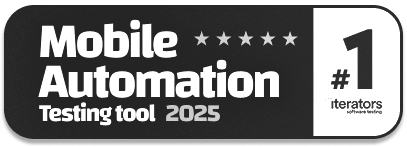Cognitive Computing in Test Automation
|
|
“Dig into every industry, and you’ll find AI changing the nature of work.”
Artificial Intelligence (AI) has become our reality. It is no longer a creative concept written in sci-fi books. You can experience the power of AI not just at your workplace but even in your personal life when you use gadgets like smartphones or smart home assistants.
When it comes to software testing, you will see the presence of AI here as well. However, we are aiming higher now, going a step further to make systems “think” like how a human tester would – that is, we are trying to imbibe the cognitive abilities of a manual tester into a machine.
Let’s understand how cognitive computing is increasingly becoming a part of test automation.
What is Cognitive Computing?
Cognitive computing tries to mimic human thought processes. To do this, the system uses AI and machine learning (ML) to understand complex problems, make decisions, and improve over time, just like how people learn from experience. It’s like giving a computer the ability to learn from the world around it and adapt based on what it learns. In everyday use, it’s similar to how smart assistants like Siri or Alexa work but more advanced.
Core Components of a Cognitive System
There are some key components that cognitive computing relies on, such as:
- Machine Learning (ML): Machine learning is like teaching a computer to learn from examples without giving it specific instructions. You feed the computer lots of data, and it looks for patterns. Over time, the computer gets better at making predictions or decisions based on this data, just like how you learn from experience. For example, if you show a computer a lot of pictures of cats and dogs, it will eventually learn to recognize the difference between them.
- Natural Language Processing (NLP): NLP is the technology that helps computers understand, interpret, and even generate human language. It allows a computer to read, analyze, and respond to text or speech in a way that feels natural. This is what allows you to talk to virtual assistants like Siri or Alexa. For example, when you ask Siri, “What’s the weather like today?” it understands your words, processes the question, and provides an answer.
- Neural Networks: Neural networks are a type of machine learning modeled after the human brain, with “neurons” that process information and “connections” that pass the data along. These networks are made up of layers of algorithms that work together to recognize patterns, make predictions, or classify information. For example, if you show a neural network lots of data about different types of fruits, it can learn to identify a fruit by its characteristics, like shape and color.
- Speech and Image Recognition: This technology allows computers to understand sounds (like human speech) or images (like photos or videos). The system “listens” to or “looks at” data and tries to identify what’s being said or seen. It then responds appropriately. For example, voice assistants use speech recognition to understand commands, while apps like Google Photos use image recognition to identify faces or objects.
- Cognitive Reasoning: Cognitive reasoning will enable a computer to solve problems, draw conclusions, and make decisions based on the information it has. The system uses logic, rules, and reasoning techniques to make sense of data and figure out what to do next.
- Knowledge Representation: This is how a computer organizes and stores information so it can easily access and use it. The system structures data into categories or “concepts,” allowing it to draw connections and understand relationships between things.

Cognitive Computing vs. AI
AI is the broad field of creating machines or software that can perform tasks that usually require human intelligence. Cognitive computing, on the other hand, is a subset of AI, but it focuses more on mimicking how the human brain works, especially how people think, learn, and make decisions. It aims to make machines “think” and adapt in ways that are similar to humans, especially when dealing with complex or unstructured information.
Cognitive computing goes beyond just following algorithms. It tries to understand, reason, and adapt to new information in a way that feels more human-like. It uses techniques like NLP, learning from past experiences, and interpreting data in a more intuitive way.
What is Cognitive Computing in Test Automation?
Instead of just following fixed rules like traditional test automation, cognitive computing systems can learn from past tests, adapt to changes, and make decisions like a human tester would. This makes testing smarter, faster, and more flexible.
How Does it Work?
In test automation, cognitive computing helps by doing the following:
- Learning from Past Data: The system looks at past tests and results to learn about the software’s behavior. When tests are run, the system records the outcomes (which tests passed, which failed, and why). It uses this data to improve future tests.
- Automatically Creating Test Cases: Based on patterns in the software and previous tests, the system can figure out what to test next. For example, if it notices that a certain page or feature was frequently changed, it will generate test cases to check that area. Read: All-Inclusive Guide to Test Case Creation in testRigor.
- Self-Healing Tests: If a test fails because something in the software changes (like a button moved or the name of a field changed), the system can recognize this change and update the test automatically. It doesn’t need a human to go in and fix the test. Read: Self-healing Tests.
- Understanding Human Language: Cognitive systems can understand instructions written in plain human language. Testers don’t need to know coding to create tests. They can just type or speak what they want to test, and the system will understand and create the necessary test. You could type something like, “Test if the login page works when the username and password are correct.” The system will understand what to check and automatically create a test for it.
- Predicting and Prioritizing Tests: The system looks at patterns from past tests and software changes to decide which areas are most likely to have issues. It then focuses testing efforts on those areas first. If the system knows that adding new features to a particular page often causes bugs, it will prioritize testing that page first rather than other areas that are less risky.
- Smart Decision Making: Based on previous test results, the system decides which tests are most important to run, which ones can be skipped, and which areas need more attention. It can also decide to run specific tests based on changes made to the software.
- Continuous Improvement: Every time a test runs, the system analyzes the results, learns from what worked and what didn’t, and uses this knowledge to improve its testing strategies. The more tests it runs, the smarter it gets.
Future of Cognitive Computing in Test Automation
As technology continues to improve, we now expect cognitive computing to change how we approach testing.
In the future, cognitive computing could lead to fully autonomous testing. It is where the system runs tests by itself, identifies issues, and even fixes broken tests without any human intervention. It will even prioritize tests based on where it thinks the most problems might occur.
Cognitive computing is changing the software testing by enabling automated test creation. Where systems generate tests based on software behavior and user interactions. These systems will become increasingly adaptable, learning from past tests and then adjusting to changes without major rework. They will also support predictive and preventative testing, using historical data. They will target likely problem areas and suggest fixes before issues arise. At the end, cognitive systems will support smarter decision-making, prioritizing tests based on factors like risk, past results, and business needs to maximize testing value.
You can see some cognitive test automation where test automation tools like testRigor make use of NLP and self-healing to mimic a human tester. Basically testRigor is a human emulator or in the form of an of AI agent.
Conclusion
It is amazing to see the rapid advancements in AI and its subsequent impact on test automation. We understand that cognitive computing will bring autonomous, self-improving, and human-like thinking to test automation. Which in turn will make enormous changes in the field and allow teams to focus more on innovation and less on repetitive tasks.
Additional Resources
- AI Engineer: The Skills and Qualifications Needed
- What are LLMs (Large Language Models)?
- AI Assistants vs AI Agents: How to Test?
- Applications of Generative AI
- How to Test Prompt Injections?
| Achieve More Than 90% Test Automation | |
| Step by Step Walkthroughs and Help | |
| 14 Day Free Trial, Cancel Anytime |












